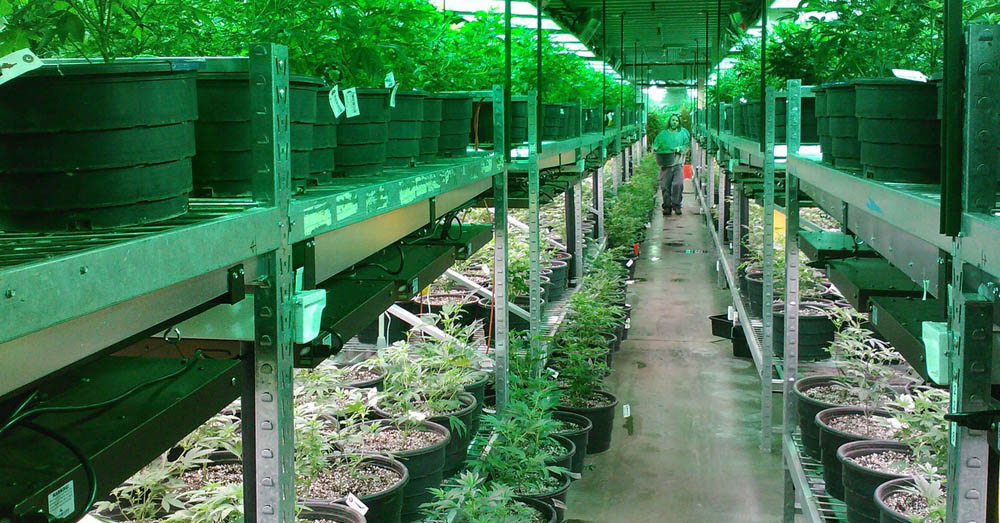Are you a new indoor grower looking for the perfect inline duct fan that will suit your needs and still be under your budget?
You must’ve been planning to upgrade your grow tent to maintain your plants better and figure out how to make the most of it.
Lucky for you, you’ve come to the right place!
In this article, I list the best inline fan for growing tents for different needs, sizes, and budgets!
The Top 4 Best Inline Fans for Grow Tents
Let’s start with the best of the best!
1) Best Overall – AC Infinity Cloudline
Its programmable temperature and humidity controller monitors the temperature and pressure in the atmosphere; it adjusts its performance appropriately to achieve your chosen ideal level.
One of the usual problems with inline fans (and regular exhaust fans) is that they are hard to clean or impossible to take apart.
This isn’t a problem with AC infinity fans. You can remove the entire AC infinity 6-inch diameter fan to clean it, so it’s easier to maintain!
And forget about extension cords! The AC Infinity Cloudline T6 has long cords of 10+ feet, so you can place it ANYWHERE you want in your grow tent.
Lastly, AC Infinity comes conveniently with all the necessary accessories (duct clamps, AC power plug, mounting hardware, and sensor probe)!

PROS
- Humidity control
- Mixed flow design
- Alarm system
- Quiet operation

CONS
- Expensive

Rating: 4.8/5
2) Best Value – Vivosun 4 Inch
Instead of the usual 6 inches, this inline fan is only 4 inches, which is the right inline fan for you if your entire grow room project is on a budget.
It’s designed for grow tents that are 2×2 or 3×3, but it will also do the job for 4×4 to 5×5 grow tents!
Don’t let the cheap inline fan price tag fool you—the Vivosun isn’t cheaply made. It’s durable and will last you for years!
This 4-inch inline fan also boasts a smooth and quiet operation, thanks to its plastic housing and plastic fan blade, and is equipped with a fan speed controller that you can easily adjust!
There’s more. The Vivosun 4-inch inline fan uses activated charcoal in its carbon filter and is very powerful at 2300 RPM, more powerful than other inline fans in its price range!

PROS
- Easy to install and use
- Fan speed controller
- Powerful
- Waterproof fan

CONS
- It still has some noise

Rating: 4.8/5
3) Best Budget – VIVOHOME 4 Inch Inline Fan
The Vivohome 4-inch inline fan is the best inline fan for grow tent housing hydroponics and for smaller grow rooms.
The Vivohome can produce 195 CFM of active air, packing so much in its compact size!
It monitors the room to ensure it ventilates the ideal air flow under varying conditions.
The fan is UV-resistant plastic, with blades made of strong ABS plastic, making it lightweight and easy to move around whether you need it for your kitchen, bakery, or grow tent!
You can even use it to inflate your kid’s inflatable castle or a camping bed. It’s a multipurpose tool, not just an inline fan!
It is also great for beginners, as it delivers air flow and efficiency at an affordable price.

PROS
- Lightweight and multipurpose
- Sleek design
- Quiet but powerful

CONS
- Suction could be better

Rating: 4.8/5
4) Best Inline Fan for 8 Inch – Terrabloom Ecmf-200
We’ve got a 6-inch inline fan and a 4-inch inline duct fan, so now let’s look at the first 8-inch inline fan on our list!
If you’re managing a big grow tent, the TerraBloom 8-inch inline fan is the best inline fan for grow tent that you can get for active air.
The TerraBloom 8-inch inline fan delivers high power and adequate ventilation with minimal wattage.
It’s their biggest advantage over other brands, especially if you’re managing a big grow room.
It might look too pricey if you calculate the cost of just a fan. But factor in the savings on your electricity bill in the long run, and you’ll see that every cent of this 8-inch inline fan is worth it!
Aside from the TerraBloom 8-inch inline fan being a good fan that runs on little power, it’s also much quieter than most inline fans, the AC infinity being one of them.
When the two fans are operated at the highest setting, the TerraBloom 8-inch inline fan produces significantly less noise than the AC infinity inline fan.

PROS
- Fewer watts, more power
- 2-year warranty
- Durable build quality with metal housing
- Quieter than most fans
- Suitable for big grow room ventilation

CONS
- The unit is quite expensive

Rating: 4.8/5
Why Should You Get an Inline Fan?
If you have a grow tent, one of the major problems you will have to deal with is the ventilation setup.
Indoor growers tend to house a lot of heat and humidity, and too much of that isn’t good for the plants.
This is where an inline duct fan comes in. An inline duct fan differs from your regular house fan or oscillating fan that will push air around your space.
It’s designed to be mounted into the ductwork without physically being there to give your tent adequate ventilation.
Inline fans are ESSENTIAL for indoor growers to create a proper ventilation system. They are also equipped with carbon odor filters to eliminate the bacteria-causing odor.
Without it, your grow room will have air circulation issues, have too much humidity and excess heat, and may even result in mold growth.
It will also mess up the temperature, consequently messing with the well-being of your plants.
Even if you have all the other extras of an indoor grower, like carbon filters, grow lights, growth media, and additional nutrients, all of those (and your entire crop) will go to waste if you don’t have the best inline fan.
How Can You Choose the Best Inline Fans?
Here are the factors to look for when buying any inline fan:
1) Fan Size
The diameter of their opening measures inline fans. The smallest diameter fan you can get is 4 inches. From there, different fan sizes go up 2 inches at a time.
On this list, we mainly focus on the 6-inch inline fans and 4-inch inline fans, as those are the most common.
How do you know which size to get for your grow rooms?
First, you must know how many cubic feet your grow rooms occupy. Inline fans measure their output by CFM rating or cubic feet of air per minute.
Ideally, the air in grow rooms should be changed out at least 30 times per hour or, if it can be afforded, 60 times per hour.
So, let’s say the cubic feet area of your grow tent is 175, then an inline fan with a 90 to 175 CFM rating would be perfect for you!
However, choosing the right size is not enough. To maximize efficiency, you also need to ensure that there are no big bends in your ducting and that you install it at an ideal place.
Inline duct fans should be placed at the farthest wall or window from the main source of air replacement and nearest to places where moisture, steam, or mold is most likely to accumulate.
2) Noise
Larger inline fans are much louder than small ones, so keep this in mind if you’re considering buying an 8-inch inline fan instead of a 6-inch one.
The more high-end inline duct fans are usually quieter, even the big ones.
To test the level of noise you are comfortable living with, the best way to test this is to go to a store and hear it work. There’s no shortcut for this.
However, there are ways to reduce the already existing noise. If you hang your inline duct fan from the ceiling, the sound will be much quieter when it reaches your ears.
You could also purchase an inline fan muffler or a solid-state speed controller to keep the fan from working at its maximum RPM when not needed.
You can also use either insulated or rigid ducting or make use of an insulated fan box.
3) Quality and Durability
Of course, you want to get your money’s worth when buying an inline fan, especially if it’s expensive.
Inline fans must work all the time for your plants and the rest of your grow tent to maintain their top condition.
You can’t have an inline fan that suddenly stops working when you’re in a growing cycle, or your plants will suffer from heat and humidity.
So whatever fan you choose should be able to keep up with those demands.
To get a durable fan, make sure the parts are made of high-quality materials, the build quality is good, and there are good reviews from those who have had the same brand and model for years!
4) Automatic Setup Features
Features like automatic speed control, humidity sensors, and timers are something you want your inline fan for grow tent to have if you’re aiming for a premium pick.
But additional automation capabilities are very convenient and will make your life much easier since you don’t have to set the ideal conditions all the time.
Additionally, some fans offer support for an alarm system as well.
You’ll have peace of mind knowing that you can leave your inline fan for grow tent alone—and not have to worry about your plants dying when you do.
5) Variable Speed Controller
Speaking of automated features, the most important extra feature you should look out for is if your inline fan has a variable speed controller.
Why? Most inline fans start at 100% or the highest fan speed available to remove the stale air in your grow tent fast.
This is good until all airflow has reached its ideal level, and you no longer need it to work at full blast.
Most tent fans already have this feature (yes, even the budget option ones!), so it should be easy to get the best inline fan equipped with this.
Always working your fan at the highest speed can do more harm than good, such as raising your electricity bills and deteriorating it fast because it’s working extra hard all the time.
This is where the variable speed controller comes in. This feature automatically lowers the fan’s speed as soon as the airflow is ideal.
It will also keep this ideal air intake level by adjusting to your growing tent’s changing conditions.
You also won’t have to check your tent to ensure ideal conditions constantly!
6) Power
When it comes to inline fans, you want to get the most powerful inline fan you can.
A high-powered fan has better fan speed and moves more fresh air faster, ventilating better for your cannabis plants. This is especially useful if your grow tent is quite big.
If you’re aiming for a budget inline fan, you might get stuck with low-powered options, so aim for the highest-powered fan within your budget.
7) Installation
This is a factor most people overlook when purchasing any inline duct fans and only think about it after they have made their purchase.
So before you buy your inline fan for grow tent, look around your space and start listing your options on where to place it and how to install it.
This way, when you purchase your inline duct fan, you’ll be able to visualize how it will look in your grow tent, and you can pick the best inline fan to match your planned installation.
8) Cord Length
Lastly, you want the cord length of your inline fan to be enough for installation. You can take care of this while planning your fan installation.
Measure the distance from where you want to install your inline fan to the nearest wall plug and get a fan that has that cord length that you need.
This way, you won’t have to deal with the hassle of extension cords in your grow tent!
What Are the Factors That Will Affect the CFM Rating?
Some users claim that companies’ CFM ratings about their products are inaccurate.
That may be true, but other factors in your grow room may also disturb your CFM rating.
Let’s look at a few common factors:
- Carbon Filter: When shopping for the best inline fan for grow tent, you might notice that some fans boast of having a carbon filter. This is a good feature as it kills bacteria and reduces mold and odor in your grow tents. However, using a carbon filter with your fan will reduce its CFM rating. Filters will set back your CFM calculation by up to 20%, so make sure to make the necessary adjustments on a fan to get the appropriate active air still.
- Grow Lights: Do you have to grow lights in your grow room? What kind? The type of lights you use may also affect your CFM rating. If you use HID lights, your grow room will get hotter than if you used CFL or LED. Your CFM will be reduced from 5% to 20% to ensure adequate grow tent ventilation and active air if the lights are not air-cooled.
Grow Room Temperature: Depending on the season and climate where you live, the temperature in your grow rooms will ALWAYS affect grow tent ventilation. Cold temperatures will require less ventilation in your grow rooms, while hotter days will require your inline fan to do extra work (about 20% to 40% more) to compensate for the decreased active air. This is because the higher the temperatures are, the higher the humidity will also be.
Frequently Asked Questions (FAQs)
More questions? I’ve got answers!
What’s the Best Inline Fan Size?
To find out the exact fan speed capacity your grow tent needs, I first need to compute the cubic feet of your space.
To find this out, multiply the height by the length of the width of your grow tent:
[height x length x width = cubic feet]
Now, whatever answer you get is your cubic feet per minute. Most inline fan manufacturers indicate this figure using CFM rating.
And as long as the CFM of your space is within the range of your inline fan’s CFM rating, you’re good!
So, for example, if your grow tent is 10 x 10 x 8, then the CFM you need to replace the air-cooled every minute would be 800.
However, you DON’T always need your inline fan for grow tent to have active air every minute, especially if it’s not a particularly hot or humid day.
In this case, you could get away with having to exchange air every 2 to 3 minutes. And to compute this, divide the original CFM into 2 or 3.
For instance, if our original CFM is 800, dividing it by 2 or 3 would make it 400 or 267 CFM.
How Often Should I Run My Inline Fan?
Ideally, an inline fan for grow tent should run throughout the day. Then it should be set up to run every 15 minutes for every hour after lights out or just before you head to bed.
After the lights go out, heat and humidity also go down, so you won’t need your inline duct fan to run all night and when the lights are out.
However, other factors like your location, climate, relative humidity, and the season will all play a factor.
If your area is particularly humid or hot, you may need to adjust your inline fan running time accordingly from 15 minutes to a few minutes more than that.
Summary
Here are my top 3 recommended inline fans!
Best Budget – Vivohome 4 inch
Not everyone needs an AC infinity in their first year as an indoor grower.
The Vivohome can do the basic job of an inline fan for small grow tents, and this one can even serve multiple other purposes!
Best Value – Vivosun 4 inch
With quieter operation and an adjustable speed controller feature, the Vivosun is a good upgrade from the Vivohome if you have a little more budget to spare.
The best part is that it is energy efficient, delivering more power for less electric consumption. You’ll surely get your money’s worth!
Best Overall – AC Infinity Cloudline t6
The AC Infinity takes the crown. In the home grower industry, it doesn’t matter who you ask; almost everyone will always answer AC Infinity inline fan.
Choosing which fan to buy might be confusing, so I recommend the Cloudline T6.
A 4-inch fan may be able to do the work for a small grower, but if you want to invest, you might be better off starting with a 6-inch fan.
This way, you wouldn’t have to worry about upgrading later on. And it will probably be a long time before you need an 8-inch.
The AC Infinity Cloudline T6 also houses all the sweet features you want your dream inline fan to have, from an alarm system to the humidity controller!
Conclusion
And that’s all I have for the best inline fan for grow tent!
Hopefully, this article has helped you make your grow room purchase decision! It is important for your grow rooms to be as functional as possible to lessen the damage.Are you looking for the best grow tents to maximize the inline fan you want to buy fully? Check out the best grow tents for cannabis!








